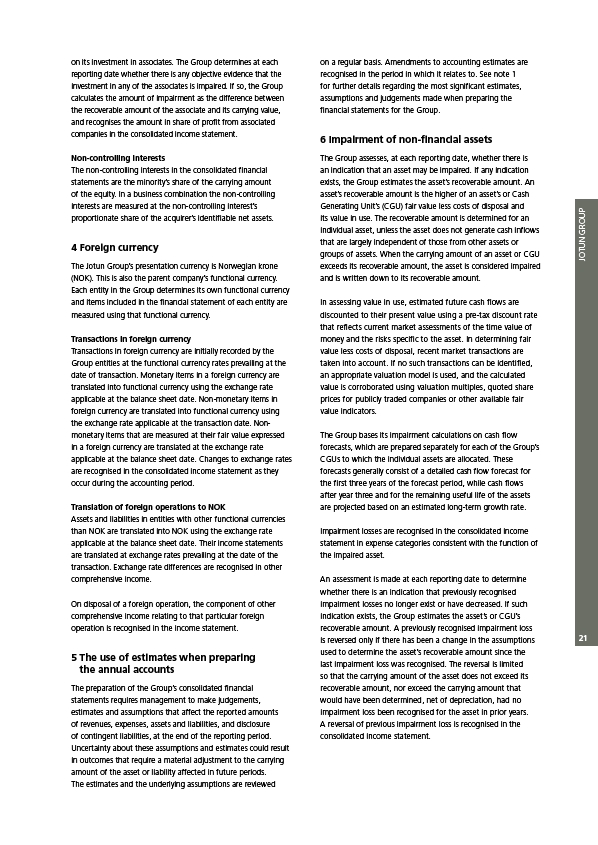
JOTUN GROUP
21
on its investment in associates. The Group determines at each
reporting date whether there is any objective evidence that the
investment in any of the associates is impaired. If so, the Group
calculates the amount of impairment as the difference between
the recoverable amount of the associate and its carrying value,
and recognises the amount in share of profit from associated
companies in the consolidated income statement.
Non-controlling interests
The non-controlling interests in the consolidated financial
statements are the minority’s share of the carrying amount
of the equity. In a business combination the non-controlling
interests are measured at the non-controlling interest’s
proportionate share of the acquirer’s identifiable net assets.
4 Foreign currency
The Jotun Group’s presentation currency is Norwegian krone
(NOK). This is also the parent company’s functional currency.
Each entity in the Group determines its own functional currency
and items included in the financial statement of each entity are
measured using that functional currency.
Transactions in foreign currency
Transactions in foreign currency are initially recorded by the
Group entities at the functional currency rates prevailing at the
date of transaction. Monetary items in a foreign currency are
translated into functional currency using the exchange rate
applicable at the balance sheet date. Non-monetary items in
foreign currency are translated into functional currency using
the exchange rate applicable at the transaction date. Nonmonetary
items that are measured at their fair value expressed
in a foreign currency are translated at the exchange rate
applicable at the balance sheet date. Changes to exchange rates
are recognised in the consolidated income statement as they
occur during the accounting period.
Translation of foreign operations to NOK
Assets and liabilities in entities with other functional currencies
than NOK are translated into NOK using the exchange rate
applicable at the balance sheet date. Their income statements
are translated at exchange rates prevailing at the date of the
transaction. Exchange rate differences are recognised in other
comprehensive income.
On disposal of a foreign operation, the component of other
comprehensive income relating to that particular foreign
operation is recognised in the income statement.
5 The use of estimates when preparing
the annual accounts
The preparation of the Group’s consolidated financial
statements requires management to make judgements,
estimates and assumptions that affect the reported amounts
of revenues, expenses, assets and liabilities, and disclosure
of contingent liabilities, at the end of the reporting period.
Uncertainty about these assumptions and estimates could result
in outcomes that require a material adjustment to the carrying
amount of the asset or liability affected in future periods.
The estimates and the underlying assumptions are reviewed
on a regular basis. Amendments to accounting estimates are
recognised in the period in which it relates to. See note 1
for further details regarding the most significant estimates,
assumptions and judgements made when preparing the
financial statements for the Group.
6 Impairment of non-financial assets
The Group assesses, at each reporting date, whether there is
an indication that an asset may be impaired. If any indication
exists, the Group estimates the asset’s recoverable amount. An
asset’s recoverable amount is the higher of an asset’s or Cash
Generating Unit’s (CGU) fair value less costs of disposal and
its value in use. The recoverable amount is determined for an
individual asset, unless the asset does not generate cash inflows
that are largely independent of those from other assets or
groups of assets. When the carrying amount of an asset or CGU
exceeds its recoverable amount, the asset is considered impaired
and is written down to its recoverable amount.
In assessing value in use, estimated future cash flows are
discounted to their present value using a pre-tax discount rate
that reflects current market assessments of the time value of
money and the risks specific to the asset. In determining fair
value less costs of disposal, recent market transactions are
taken into account. If no such transactions can be identified,
an appropriate valuation model is used, and the calculated
value is corroborated using valuation multiples, quoted share
prices for publicly traded companies or other available fair
value indicators.
The Group bases its impairment calculations on cash flow
forecasts, which are prepared separately for each of the Group’s
CGUs to which the individual assets are allocated. These
forecasts generally consist of a detailed cash flow forecast for
the first three years of the forecast period, while cash flows
after year three and for the remaining useful life of the assets
are projected based on an estimated long-term growth rate.
Impairment losses are recognised in the consolidated income
statement in expense categories consistent with the function of
the impaired asset.
An assessment is made at each reporting date to determine
whether there is an indication that previously recognised
impairment losses no longer exist or have decreased. If such
indication exists, the Group estimates the asset’s or CGU’s
recoverable amount. A previously recognised impairment loss
is reversed only if there has been a change in the assumptions
used to determine the asset’s recoverable amount since the
last impairment loss was recognised. The reversal is limited
so that the carrying amount of the asset does not exceed its
recoverable amount, nor exceed the carrying amount that
would have been determined, net of depreciation, had no
impairment loss been recognised for the asset in prior years.
A reversal of previous impairment loss is recognised in the
consolidated income statement.